Analyzing Change in Demand, Supply, and Impact of Protectionism Policy
VerifiedAdded on 2023/06/09
|10
|1465
|293
Essay
AI Summary
This economics essay provides a detailed analysis of demand and supply dynamics, distinguishing between changes in demand and changes in quantity demanded, and their effects on market equilibrium. It further examines the implications of protectionist policies, particularly focusing on the tariffs imposed by the U.S. and their potential impact on trade deficits and economic competitiveness. The essay critiques the notion of trade as a zero-sum game and argues that protectionism can lead to distortions in trade, reduced social welfare, and harm the competitive position of domestic companies. Referencing relevant economic theories, such as absolute and comparative advantage, the analysis concludes that protectionist measures may not achieve their intended goals and could have adverse effects on the economy. Desklib offers this assignment solution along with a wealth of resources for students.

Running Head: ECONOMICS ASSIGNMENT
Economics Assignment
Name of the Student
Name of the University
Course ID
Economics Assignment
Name of the Student
Name of the University
Course ID
Paraphrase This Document
Need a fresh take? Get an instant paraphrase of this document with our AI Paraphraser
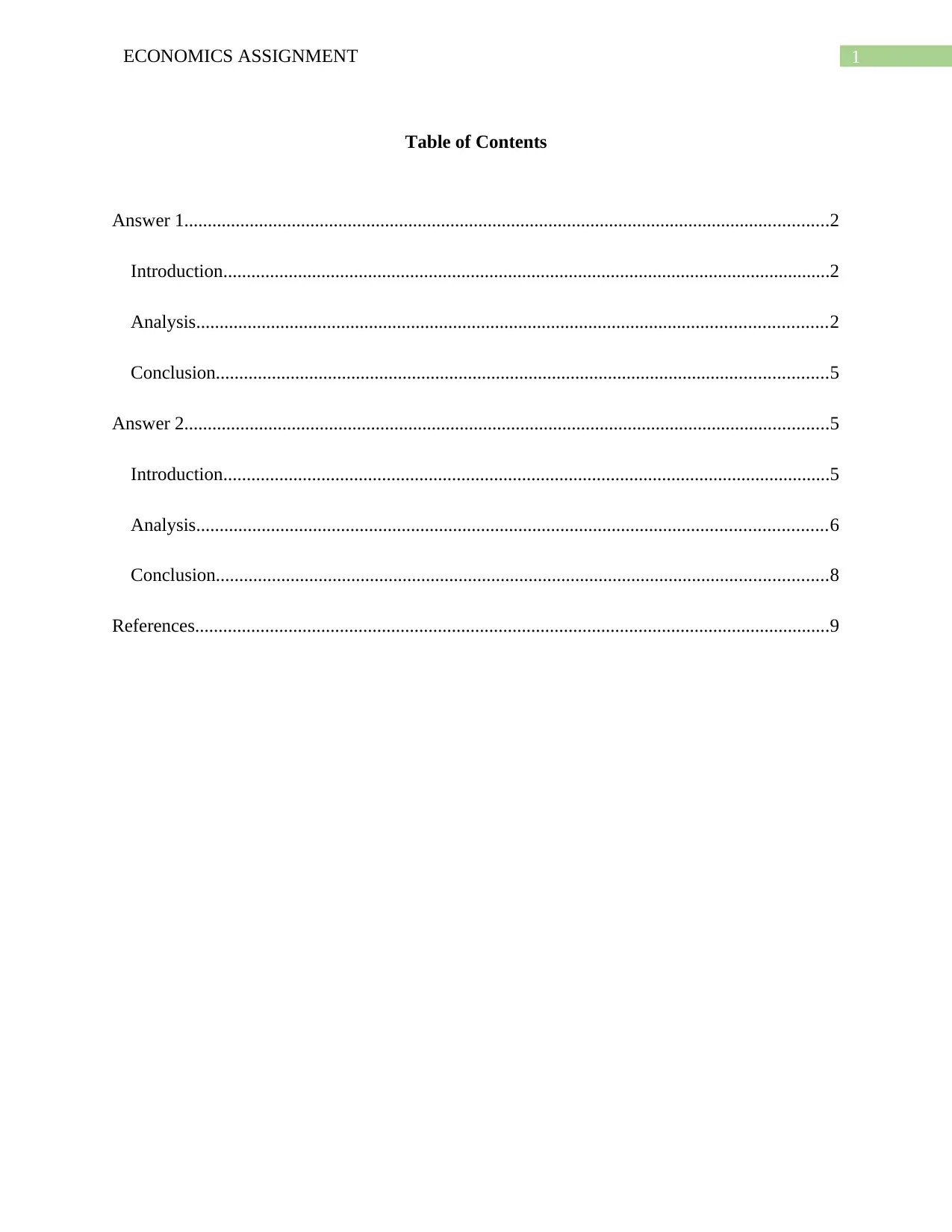
1ECONOMICS ASSIGNMENT
Table of Contents
Answer 1..........................................................................................................................................2
Introduction..................................................................................................................................2
Analysis.......................................................................................................................................2
Conclusion...................................................................................................................................5
Answer 2..........................................................................................................................................5
Introduction..................................................................................................................................5
Analysis.......................................................................................................................................6
Conclusion...................................................................................................................................8
References........................................................................................................................................9
Table of Contents
Answer 1..........................................................................................................................................2
Introduction..................................................................................................................................2
Analysis.......................................................................................................................................2
Conclusion...................................................................................................................................5
Answer 2..........................................................................................................................................5
Introduction..................................................................................................................................5
Analysis.......................................................................................................................................6
Conclusion...................................................................................................................................8
References........................................................................................................................................9

2ECONOMICS ASSIGNMENT
Answer 1
Introduction
In economics, demand of a good refers to the willingness to buy a good backed by the
purchasing power of people (Baumol & Blinder, 2015). The concept of quantity demand
however differs from that of demand. This section briefly distinguishes between change in
demand and change in quantity demand and its impact on market equilibrium.
Analysis
Change in quantity demand
Demand curve of a commodity represents the relationship between price and quantity
demanded of the commodity. The demand curve slopes downward indicating an inverse relation
between price and quantity demand. The term quantity demand is a narrow term. It indicates a
specific point on the demand curve. From the demand curve, effect of a change in price on the
quantity demanded can be found. An increase in price is associated with a decline in quantity
demand and vice-versa. Effect of a price increase or price decrease can be observed from a
movement along the demand curve either from left to right or right to left (McKenzie & Lee,
2016). These movements are called change in quantity demanded and described as expansion or
contraction of demand. Quantity demanded of a commodity change only due to a change in price
holding other factors constant.
Answer 1
Introduction
In economics, demand of a good refers to the willingness to buy a good backed by the
purchasing power of people (Baumol & Blinder, 2015). The concept of quantity demand
however differs from that of demand. This section briefly distinguishes between change in
demand and change in quantity demand and its impact on market equilibrium.
Analysis
Change in quantity demand
Demand curve of a commodity represents the relationship between price and quantity
demanded of the commodity. The demand curve slopes downward indicating an inverse relation
between price and quantity demand. The term quantity demand is a narrow term. It indicates a
specific point on the demand curve. From the demand curve, effect of a change in price on the
quantity demanded can be found. An increase in price is associated with a decline in quantity
demand and vice-versa. Effect of a price increase or price decrease can be observed from a
movement along the demand curve either from left to right or right to left (McKenzie & Lee,
2016). These movements are called change in quantity demanded and described as expansion or
contraction of demand. Quantity demanded of a commodity change only due to a change in price
holding other factors constant.
⊘ This is a preview!⊘
Do you want full access?
Subscribe today to unlock all pages.

Trusted by 1+ million students worldwide

3ECONOMICS ASSIGNMENT
Figure 1: effect of a change in Quantity demand
The figure above shows effect of a change in quantity demanded of a commodity. The
demand curve is given as DD. Equilibrium obtained from the intersection of demand and supply
curve is at E giving equilibrium price as P* and equilibrium quantity as Q* (Jain & Ohri, 2015).
Now an increase in price from P* to P1 causes a decline in demand as shown by the point A. In
contrast, a decline in price to P2 reduces quantity demanded and a new point C is obtained on the
demand curve.
Change in demand
In contrast, in response to change in demand influencing other factors the demand curve
shifts to a new position. When demand changes due to factors other than prices it is called
change in demand. This indicates either a larger or a smaller demand at a given price. Change in
demand occurs when there is a change income, or change in distribution of income or price of
the related goods, or change in people’s expectation or such others. The change in demand
actually represent a change in composition of demand. Demand changes are of two types. An
Figure 1: effect of a change in Quantity demand
The figure above shows effect of a change in quantity demanded of a commodity. The
demand curve is given as DD. Equilibrium obtained from the intersection of demand and supply
curve is at E giving equilibrium price as P* and equilibrium quantity as Q* (Jain & Ohri, 2015).
Now an increase in price from P* to P1 causes a decline in demand as shown by the point A. In
contrast, a decline in price to P2 reduces quantity demanded and a new point C is obtained on the
demand curve.
Change in demand
In contrast, in response to change in demand influencing other factors the demand curve
shifts to a new position. When demand changes due to factors other than prices it is called
change in demand. This indicates either a larger or a smaller demand at a given price. Change in
demand occurs when there is a change income, or change in distribution of income or price of
the related goods, or change in people’s expectation or such others. The change in demand
actually represent a change in composition of demand. Demand changes are of two types. An
Paraphrase This Document
Need a fresh take? Get an instant paraphrase of this document with our AI Paraphraser
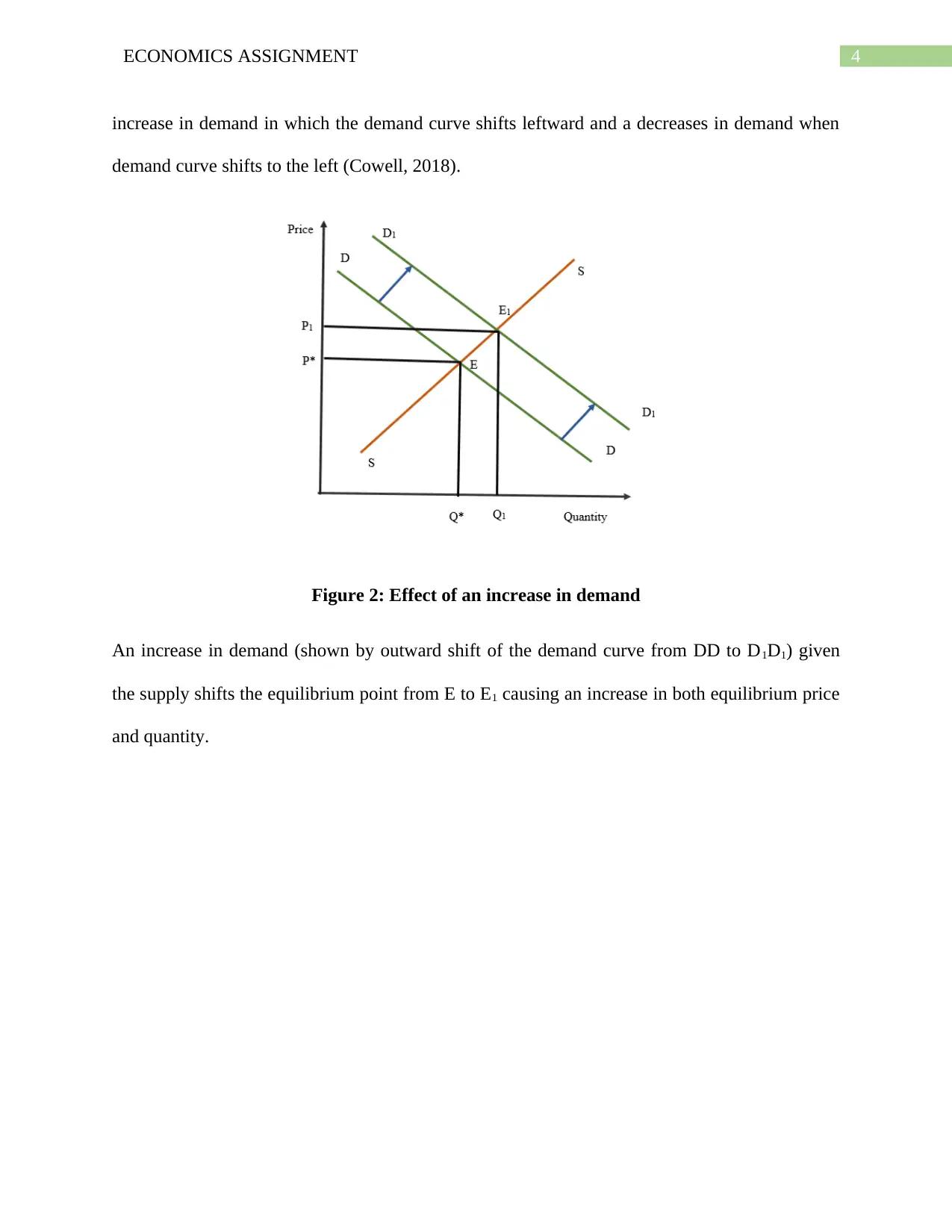
4ECONOMICS ASSIGNMENT
increase in demand in which the demand curve shifts leftward and a decreases in demand when
demand curve shifts to the left (Cowell, 2018).
Figure 2: Effect of an increase in demand
An increase in demand (shown by outward shift of the demand curve from DD to D1D1) given
the supply shifts the equilibrium point from E to E1 causing an increase in both equilibrium price
and quantity.
increase in demand in which the demand curve shifts leftward and a decreases in demand when
demand curve shifts to the left (Cowell, 2018).
Figure 2: Effect of an increase in demand
An increase in demand (shown by outward shift of the demand curve from DD to D1D1) given
the supply shifts the equilibrium point from E to E1 causing an increase in both equilibrium price
and quantity.
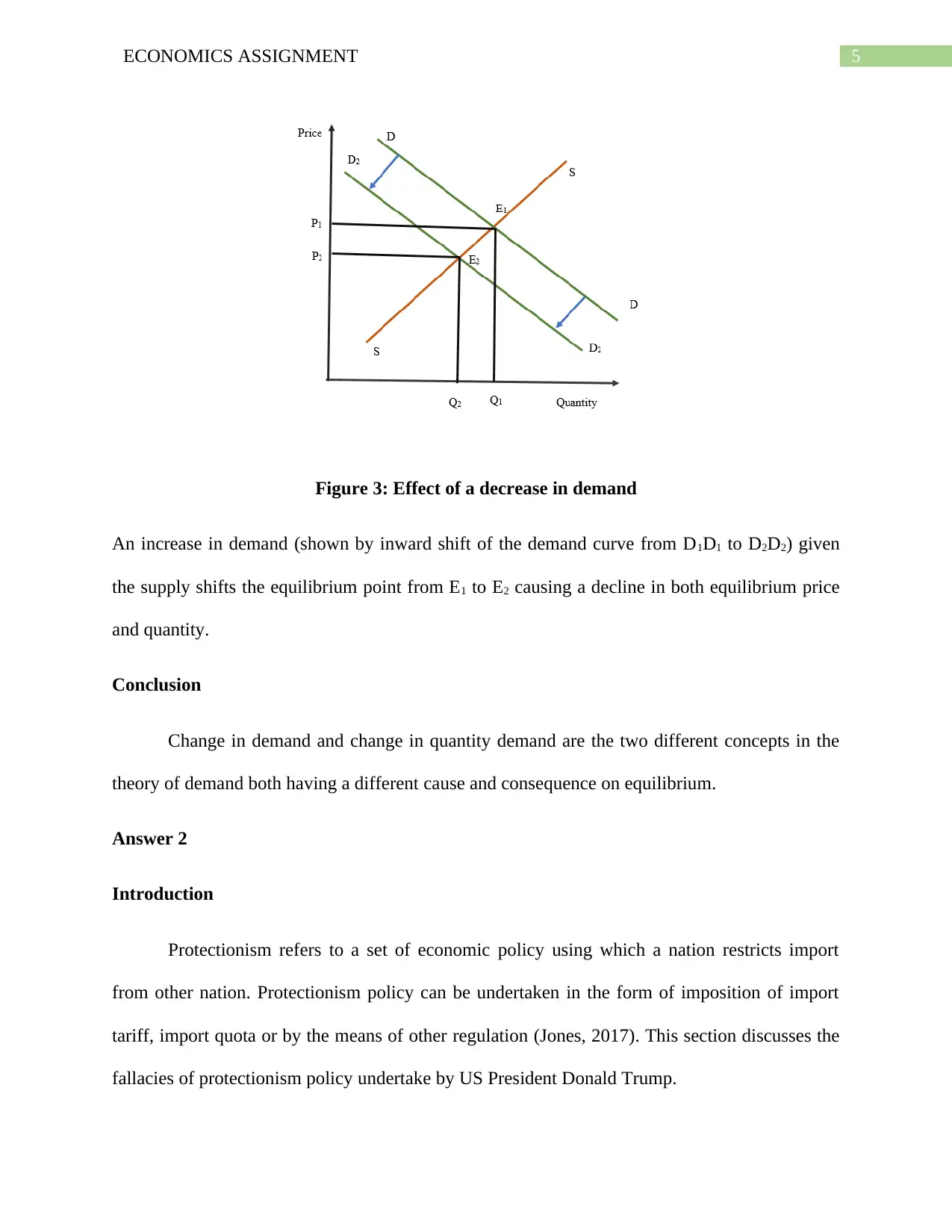
5ECONOMICS ASSIGNMENT
Figure 3: Effect of a decrease in demand
An increase in demand (shown by inward shift of the demand curve from D1D1 to D2D2) given
the supply shifts the equilibrium point from E1 to E2 causing a decline in both equilibrium price
and quantity.
Conclusion
Change in demand and change in quantity demand are the two different concepts in the
theory of demand both having a different cause and consequence on equilibrium.
Answer 2
Introduction
Protectionism refers to a set of economic policy using which a nation restricts import
from other nation. Protectionism policy can be undertaken in the form of imposition of import
tariff, import quota or by the means of other regulation (Jones, 2017). This section discusses the
fallacies of protectionism policy undertake by US President Donald Trump.
Figure 3: Effect of a decrease in demand
An increase in demand (shown by inward shift of the demand curve from D1D1 to D2D2) given
the supply shifts the equilibrium point from E1 to E2 causing a decline in both equilibrium price
and quantity.
Conclusion
Change in demand and change in quantity demand are the two different concepts in the
theory of demand both having a different cause and consequence on equilibrium.
Answer 2
Introduction
Protectionism refers to a set of economic policy using which a nation restricts import
from other nation. Protectionism policy can be undertaken in the form of imposition of import
tariff, import quota or by the means of other regulation (Jones, 2017). This section discusses the
fallacies of protectionism policy undertake by US President Donald Trump.
⊘ This is a preview!⊘
Do you want full access?
Subscribe today to unlock all pages.

Trusted by 1+ million students worldwide
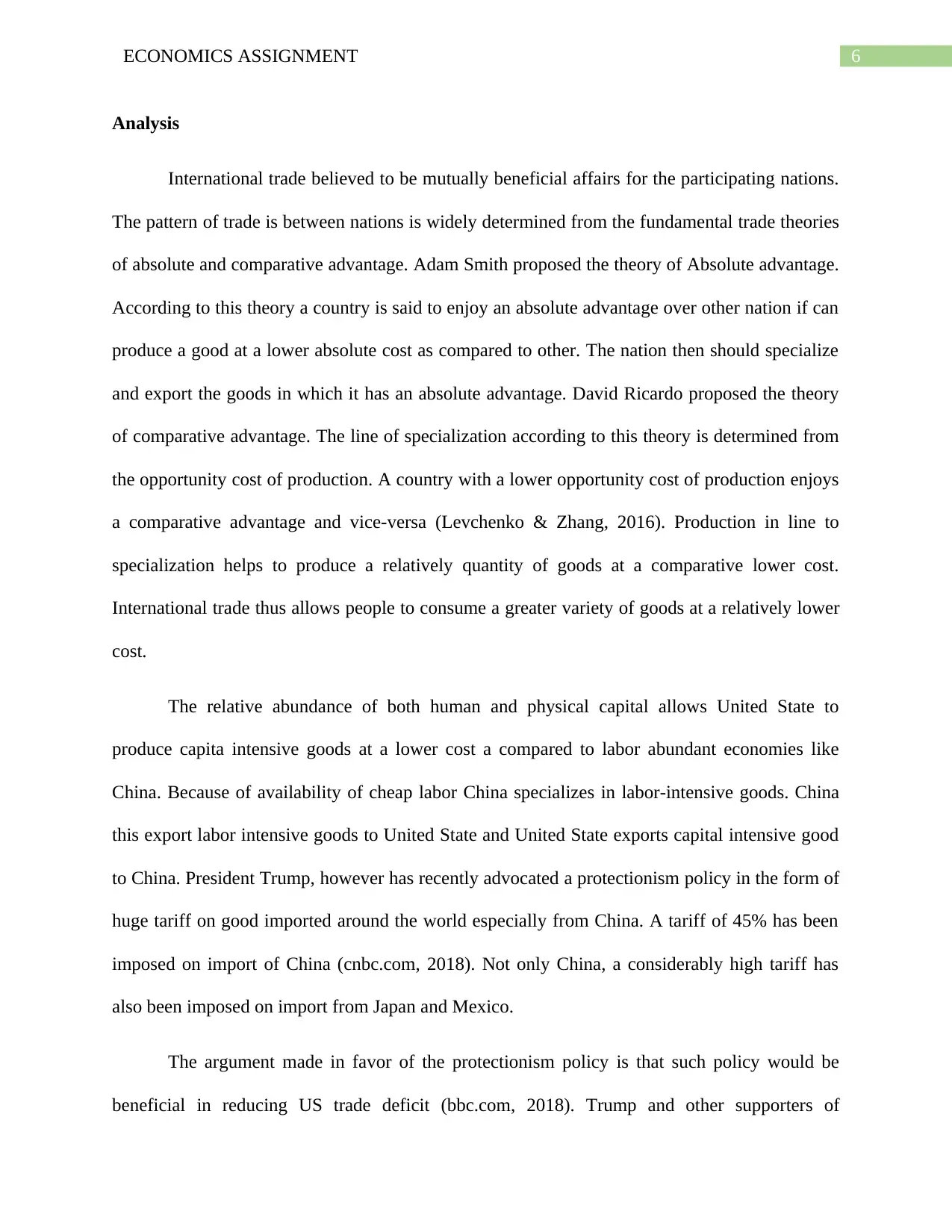
6ECONOMICS ASSIGNMENT
Analysis
International trade believed to be mutually beneficial affairs for the participating nations.
The pattern of trade is between nations is widely determined from the fundamental trade theories
of absolute and comparative advantage. Adam Smith proposed the theory of Absolute advantage.
According to this theory a country is said to enjoy an absolute advantage over other nation if can
produce a good at a lower absolute cost as compared to other. The nation then should specialize
and export the goods in which it has an absolute advantage. David Ricardo proposed the theory
of comparative advantage. The line of specialization according to this theory is determined from
the opportunity cost of production. A country with a lower opportunity cost of production enjoys
a comparative advantage and vice-versa (Levchenko & Zhang, 2016). Production in line to
specialization helps to produce a relatively quantity of goods at a comparative lower cost.
International trade thus allows people to consume a greater variety of goods at a relatively lower
cost.
The relative abundance of both human and physical capital allows United State to
produce capita intensive goods at a lower cost a compared to labor abundant economies like
China. Because of availability of cheap labor China specializes in labor-intensive goods. China
this export labor intensive goods to United State and United State exports capital intensive good
to China. President Trump, however has recently advocated a protectionism policy in the form of
huge tariff on good imported around the world especially from China. A tariff of 45% has been
imposed on import of China (cnbc.com, 2018). Not only China, a considerably high tariff has
also been imposed on import from Japan and Mexico.
The argument made in favor of the protectionism policy is that such policy would be
beneficial in reducing US trade deficit (bbc.com, 2018). Trump and other supporters of
Analysis
International trade believed to be mutually beneficial affairs for the participating nations.
The pattern of trade is between nations is widely determined from the fundamental trade theories
of absolute and comparative advantage. Adam Smith proposed the theory of Absolute advantage.
According to this theory a country is said to enjoy an absolute advantage over other nation if can
produce a good at a lower absolute cost as compared to other. The nation then should specialize
and export the goods in which it has an absolute advantage. David Ricardo proposed the theory
of comparative advantage. The line of specialization according to this theory is determined from
the opportunity cost of production. A country with a lower opportunity cost of production enjoys
a comparative advantage and vice-versa (Levchenko & Zhang, 2016). Production in line to
specialization helps to produce a relatively quantity of goods at a comparative lower cost.
International trade thus allows people to consume a greater variety of goods at a relatively lower
cost.
The relative abundance of both human and physical capital allows United State to
produce capita intensive goods at a lower cost a compared to labor abundant economies like
China. Because of availability of cheap labor China specializes in labor-intensive goods. China
this export labor intensive goods to United State and United State exports capital intensive good
to China. President Trump, however has recently advocated a protectionism policy in the form of
huge tariff on good imported around the world especially from China. A tariff of 45% has been
imposed on import of China (cnbc.com, 2018). Not only China, a considerably high tariff has
also been imposed on import from Japan and Mexico.
The argument made in favor of the protectionism policy is that such policy would be
beneficial in reducing US trade deficit (bbc.com, 2018). Trump and other supporters of
Paraphrase This Document
Need a fresh take? Get an instant paraphrase of this document with our AI Paraphraser
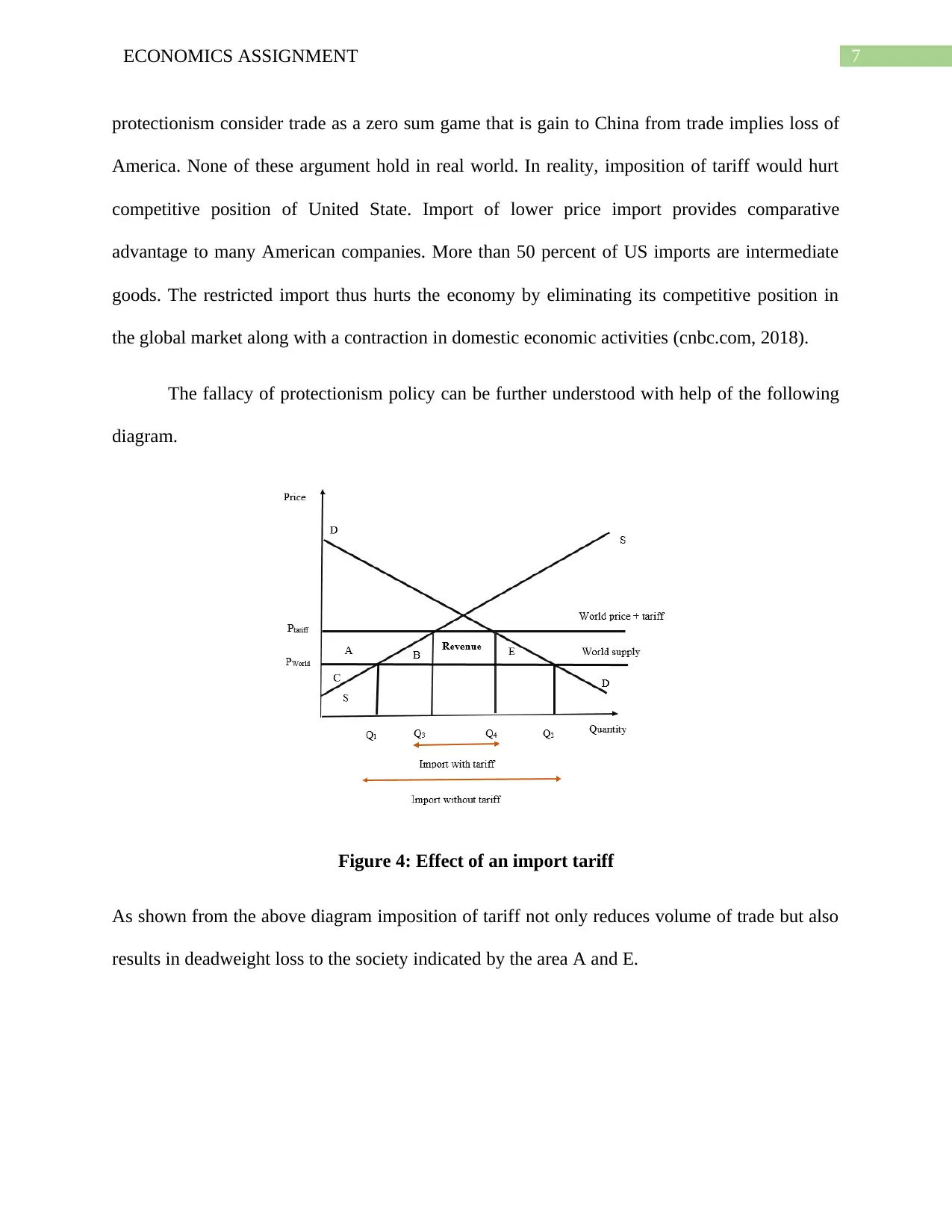
7ECONOMICS ASSIGNMENT
protectionism consider trade as a zero sum game that is gain to China from trade implies loss of
America. None of these argument hold in real world. In reality, imposition of tariff would hurt
competitive position of United State. Import of lower price import provides comparative
advantage to many American companies. More than 50 percent of US imports are intermediate
goods. The restricted import thus hurts the economy by eliminating its competitive position in
the global market along with a contraction in domestic economic activities (cnbc.com, 2018).
The fallacy of protectionism policy can be further understood with help of the following
diagram.
Figure 4: Effect of an import tariff
As shown from the above diagram imposition of tariff not only reduces volume of trade but also
results in deadweight loss to the society indicated by the area A and E.
protectionism consider trade as a zero sum game that is gain to China from trade implies loss of
America. None of these argument hold in real world. In reality, imposition of tariff would hurt
competitive position of United State. Import of lower price import provides comparative
advantage to many American companies. More than 50 percent of US imports are intermediate
goods. The restricted import thus hurts the economy by eliminating its competitive position in
the global market along with a contraction in domestic economic activities (cnbc.com, 2018).
The fallacy of protectionism policy can be further understood with help of the following
diagram.
Figure 4: Effect of an import tariff
As shown from the above diagram imposition of tariff not only reduces volume of trade but also
results in deadweight loss to the society indicated by the area A and E.
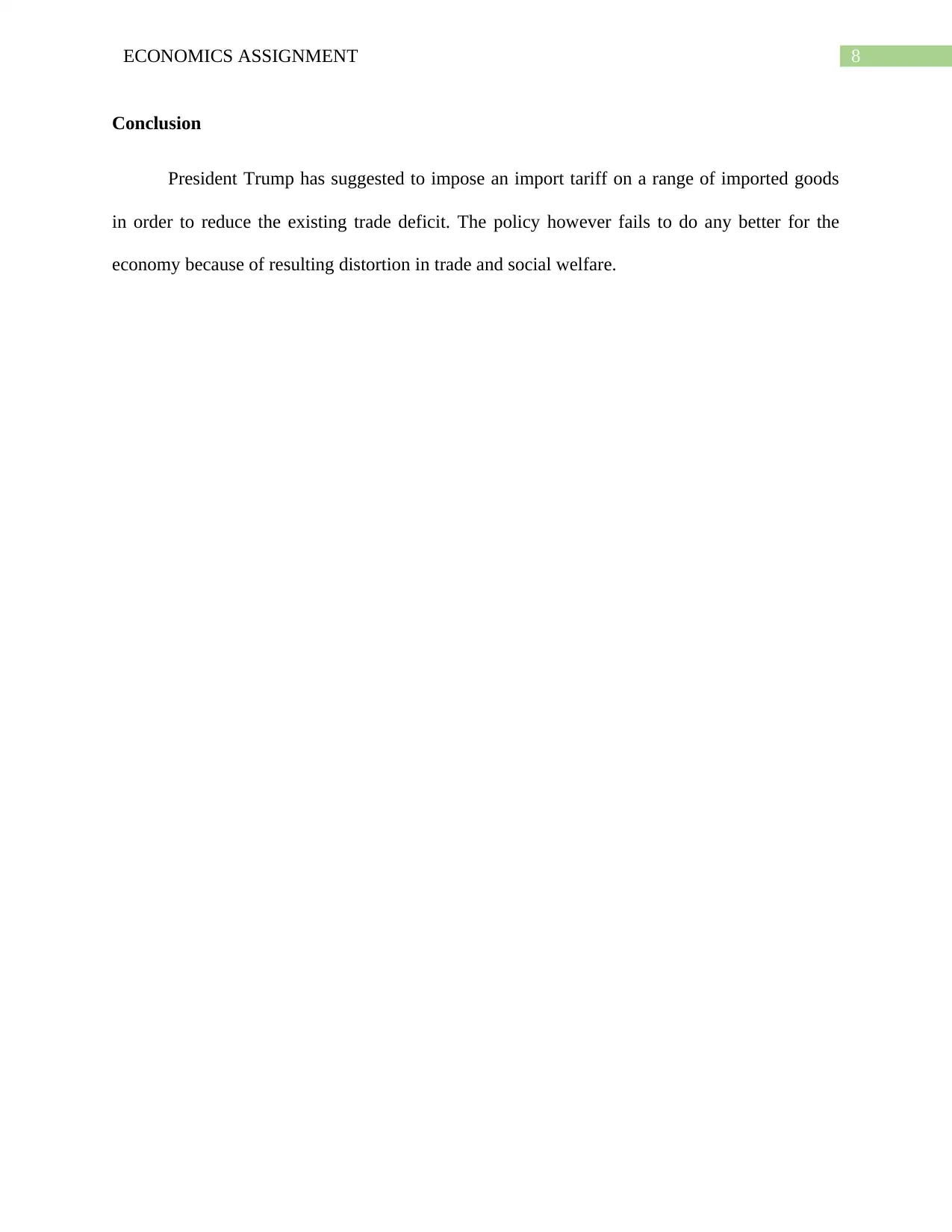
8ECONOMICS ASSIGNMENT
Conclusion
President Trump has suggested to impose an import tariff on a range of imported goods
in order to reduce the existing trade deficit. The policy however fails to do any better for the
economy because of resulting distortion in trade and social welfare.
Conclusion
President Trump has suggested to impose an import tariff on a range of imported goods
in order to reduce the existing trade deficit. The policy however fails to do any better for the
economy because of resulting distortion in trade and social welfare.
⊘ This is a preview!⊘
Do you want full access?
Subscribe today to unlock all pages.

Trusted by 1+ million students worldwide
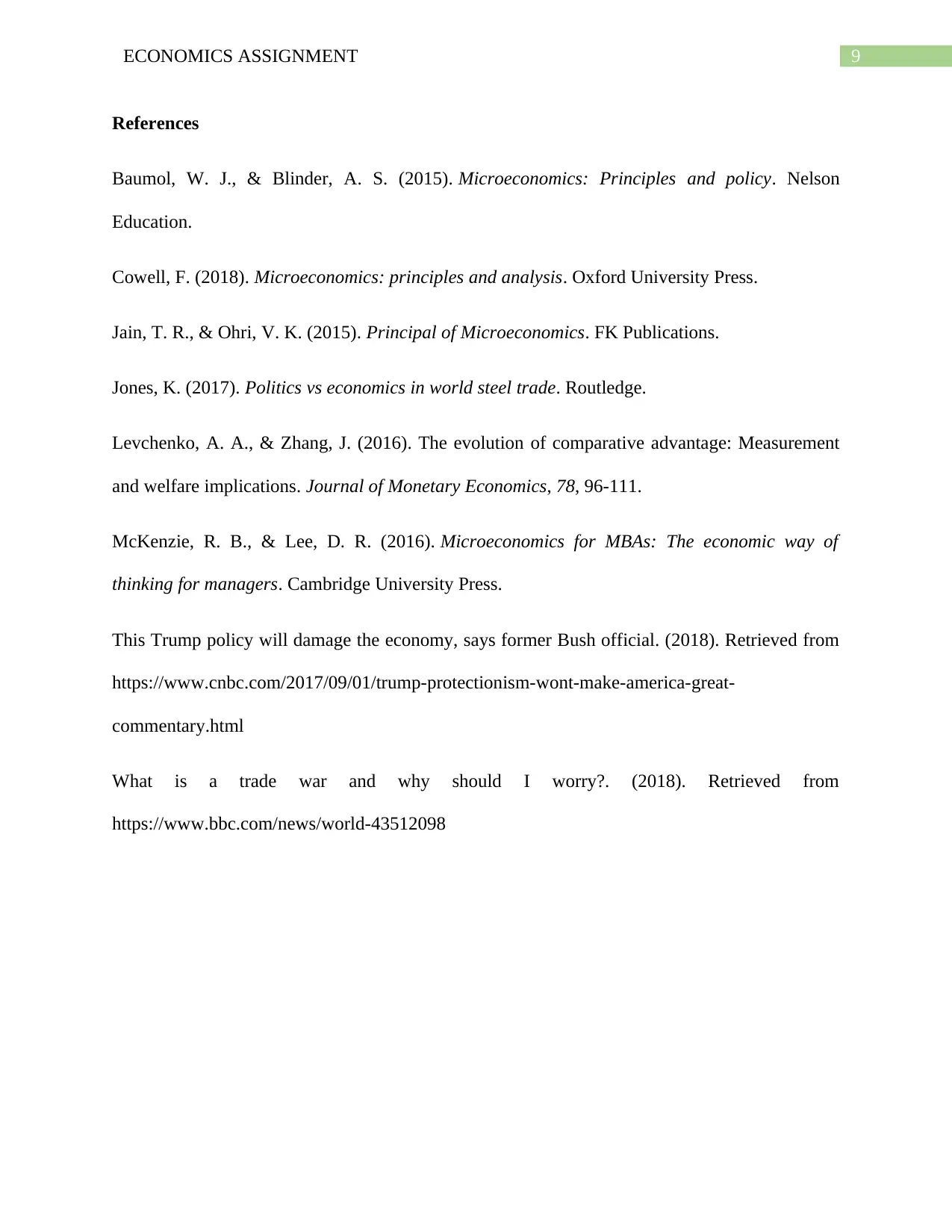
9ECONOMICS ASSIGNMENT
References
Baumol, W. J., & Blinder, A. S. (2015). Microeconomics: Principles and policy. Nelson
Education.
Cowell, F. (2018). Microeconomics: principles and analysis. Oxford University Press.
Jain, T. R., & Ohri, V. K. (2015). Principal of Microeconomics. FK Publications.
Jones, K. (2017). Politics vs economics in world steel trade. Routledge.
Levchenko, A. A., & Zhang, J. (2016). The evolution of comparative advantage: Measurement
and welfare implications. Journal of Monetary Economics, 78, 96-111.
McKenzie, R. B., & Lee, D. R. (2016). Microeconomics for MBAs: The economic way of
thinking for managers. Cambridge University Press.
This Trump policy will damage the economy, says former Bush official. (2018). Retrieved from
https://www.cnbc.com/2017/09/01/trump-protectionism-wont-make-america-great-
commentary.html
What is a trade war and why should I worry?. (2018). Retrieved from
https://www.bbc.com/news/world-43512098
References
Baumol, W. J., & Blinder, A. S. (2015). Microeconomics: Principles and policy. Nelson
Education.
Cowell, F. (2018). Microeconomics: principles and analysis. Oxford University Press.
Jain, T. R., & Ohri, V. K. (2015). Principal of Microeconomics. FK Publications.
Jones, K. (2017). Politics vs economics in world steel trade. Routledge.
Levchenko, A. A., & Zhang, J. (2016). The evolution of comparative advantage: Measurement
and welfare implications. Journal of Monetary Economics, 78, 96-111.
McKenzie, R. B., & Lee, D. R. (2016). Microeconomics for MBAs: The economic way of
thinking for managers. Cambridge University Press.
This Trump policy will damage the economy, says former Bush official. (2018). Retrieved from
https://www.cnbc.com/2017/09/01/trump-protectionism-wont-make-america-great-
commentary.html
What is a trade war and why should I worry?. (2018). Retrieved from
https://www.bbc.com/news/world-43512098
1 out of 10
Related Documents
Your All-in-One AI-Powered Toolkit for Academic Success.
+13062052269
info@desklib.com
Available 24*7 on WhatsApp / Email
![[object Object]](/_next/static/media/star-bottom.7253800d.svg)
Unlock your academic potential
Copyright © 2020–2025 A2Z Services. All Rights Reserved. Developed and managed by ZUCOL.





